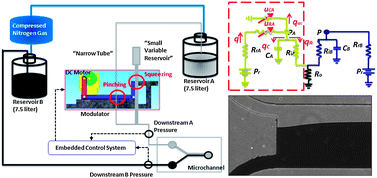Existing microfluidic systems can control local chemical environments by directing the interface between laminar flowing streams for applications ranging from subcellular stimulation to fuel cells. However, conventional flow modulation methods have not yet provided a robust and reliable way to dynamically control laminar flow interfaces for very long time periods. Such control is important in biological investigations, since response times for living cells and tissues can be as long as several days. Here, we describe a novel long-term, high-speed approach that employs modulation of fluidic resistance and fluidic capacitance between a fluid reservoir and a microfluidic network with feedback control to enable long-term dynamic control of a microfluidic interface in time and space. Our method involves constricting a narrow tube through a pinching approach to modulate fluidic resistance while also controlling a small variable reservoir in the fluidic network through a squeezing approach to modulate fluidic capacitance. We designed a well-tuned proportional-integral-derivative (PID) controller for the closed-loop control system that resulted in control of pressure for short-term (2 s) and long-term (15 h) experiments. Further, we integrated a pressure-based feedback control approach into this method, which enables both long-term spatiotemporal control of our microfluidic interface at frequencies greater than 1 Hz and a reservoir capacity to enable experiments for longer than 60 days. This long-term and high-speed control is not possible with standard microfluidic laboratory practices. Our system has a diversity of potential applications including long-term cellular studies in cancer metastasis or embryonic development.

You have access to this article
 Please wait while we load your content...
Something went wrong. Try again?
Please wait while we load your content...
Something went wrong. Try again?


 Please wait while we load your content...
Please wait while we load your content...